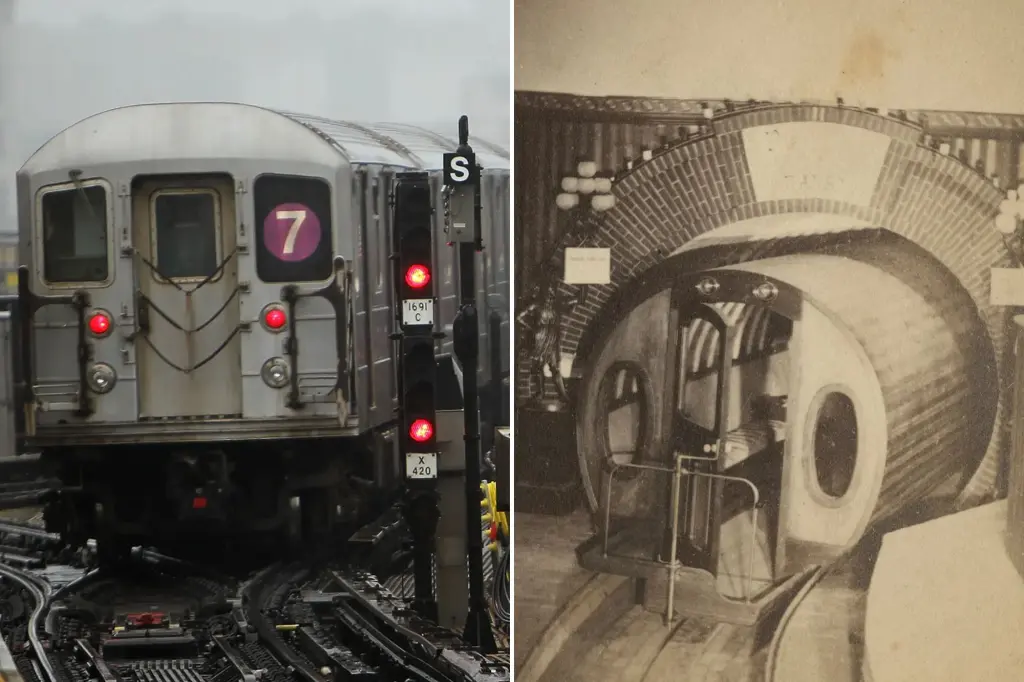The Secret Subway That Nearly Changed New York
In a daring act that blended innovation with defiance, inventor Alfred Ely Beach unveiled his unauthorized pneumatic subway beneath Broadway on February 26, 1870. New York’s elite descended through the basement of Devlin’s clothing store in Tribeca to discover an engineering marvel that had been constructed right under City Hall’s nose. Beach, combining technical brilliance with showmanship, hadn’t merely built a transportation prototype—he had created an immersive experience designed to captivate New York’s influencers and bypass the political roadblocks that had previously stymied progress. As Matthew Algeo details in his book “New York’s Secret Subway,” Beach transformed what could have been a utilitarian demonstration into a sensory spectacle. The waiting room boasted chandeliers and a grand piano, a fountain stocked with goldfish provided ambient beauty, while the subway car itself featured plush upholstery and zirconia lighting. This wasn’t merely decoration—it was strategic marketing for a vision of urban transit that prioritized comfort and dignity at a time when New Yorkers endured slow, dirty omnibuses and streetcars.
Beach’s audacious gambit represented a calculated risk born of frustration with conventional channels of approval. Having been repeatedly thwarted by the entrenched transportation interests and their political allies, most notably Boss Tweed, Beach hatched a plan as clever as it was controversial. He secured permits for what officials believed would be a modest pneumatic mail tube, then secretly expanded the project into an eight-foot-wide, 300-foot tunnel capable of carrying passengers. The strategy was brilliantly simple: rather than argue for permission on paper, Beach would present New Yorkers with a functional, superior alternative to surface transportation. He believed the public’s enthusiastic response would generate enough political momentum to overcome resistance from the operators of stagecoaches and horse-drawn streetcars who paid handsomely to maintain their monopoly. Beach’s underground reception wasn’t just a product launch—it was a carefully orchestrated political campaign. Guests were encouraged to sign petitions supporting the extension of Beach’s line, with thousands lending their signatures to his cause.
The technical achievement alone was remarkable for 1870. Beach had engineered a transportation system that addressed virtually every complaint about existing options. His pneumatic subway was quiet, cool, and clean—a stark contrast to the noisy, sweltering, filth-laden experience of surface travel. Powered by a massive fan that pushed and pulled air to propel the car through the tunnel, the system represented the pinnacle of Victorian-era mechanical innovation. Beach believed so deeply in his solution to Manhattan’s increasingly paralyzing traffic that he risked not only his fortune but potentially his freedom. Had the tunnel collapsed during construction or operation, the unauthorized excavation beneath one of the city’s busiest thoroughfares could have resulted in catastrophic consequences both physically and legally. Algeo aptly compares the risk to the ill-fated Titan submersible that imploded in 2023—both represented bold technological ventures that operated outside established safety protocols, though Beach’s gamble fortunately ended without tragedy.
The clandestine nature of the project couldn’t remain secret forever. Charles Guidet, a contractor who had recently repaved Broadway, noticed alarming signs that the street was sinking near City Hall—approximately nine inches in some areas. When the mayor confirmed similar observations and demanded investigation, Beach boldly refused access, claiming the mayor had “no right to interfere.” This defiance highlighted the tension between innovation and regulation that continues to characterize infrastructure development. Despite the initial public enthusiasm and extensive media coverage, Beach’s subway remained confined to its original one-block demonstration. The political alliance between streetcar interests and City Hall proved too powerful, effectively blocking the legislative approvals needed to extend the line uptown. Beach’s vision of a pneumatic network beneath Manhattan remained unfulfilled, a victim of the very political obstacles he had tried to circumvent through his unorthodox approach.
While Boss Tweed and his allies succeeded in limiting Beach’s project, they couldn’t entirely suppress the momentum toward improved public transportation. Tweed’s attempts to revoke Beach’s charter failed, and rival transportation experiments, like Charles T. Harvey’s elevated line, proceeded despite opposition. The pneumatic subway eventually closed in 1873 after three years of operation, and its tunnel was sealed and largely forgotten until workers accidentally broke through its wall during excavation for the City Hall subway station in 1912. New York would wait until October 27, 1904, for its first official subway line to open, with service reaching lower Broadway only in 1918—nearly five decades after Beach’s demonstration. This pattern feels strikingly familiar in our current era, where innovative infrastructure projects still navigate complex permitting processes, community opposition, and legislative bottlenecks. Beach’s experience demonstrated that the primary obstacles to transportation innovation weren’t technical but political—a lesson that remains relevant as cities continue to struggle with implementing solutions to congestion and mobility challenges.
The parallels between Beach’s pneumatic subway and contemporary transportation proposals like Elon Musk’s Hyperloop are striking. Both systems embrace the concept of sealed tubes and streamlined vehicles promising speed and cleanliness. Both entrepreneurs leveraged public fascination and media attention to build support for their visions. Yet as Algeo points out, there’s a crucial difference: “Beach built a complete working version of his concept, something that Musk has yet to do.” Beach’s achievement was grounded in Victorian mechanical principles that, while innovative, remained technically feasible with the resources and knowledge of his era. In contrast, the Hyperloop relies on more complex systems like vacuum maintenance and magnetic propulsion that have proven challenging to implement at scale. Beach’s story offers a cautionary tale about the intersection of innovation, politics, and public transportation—reminding us that technical feasibility alone doesn’t guarantee implementation. As cities worldwide continue to search for sustainable transportation solutions, Beach’s underground experiment stands as both inspiration and warning: a testament to human ingenuity and a reminder of how entrenched interests can derail even the most promising innovations.











